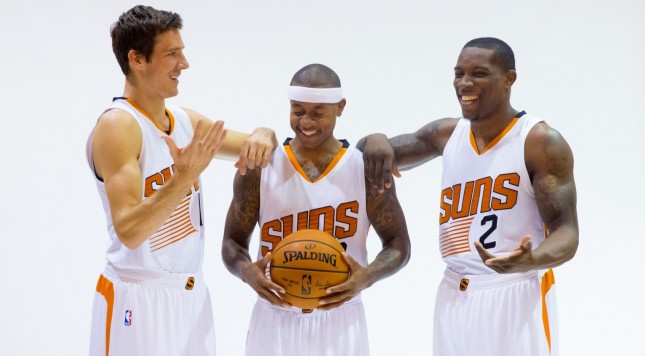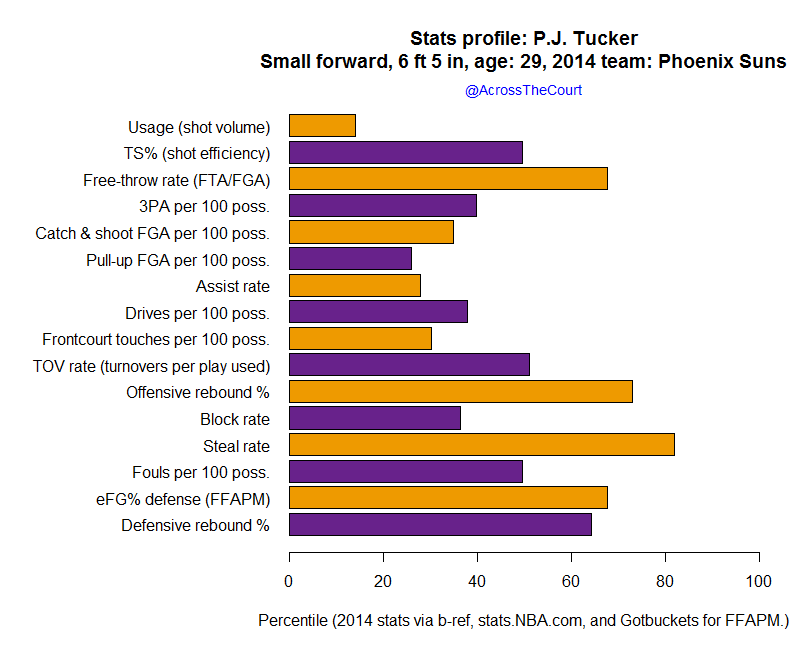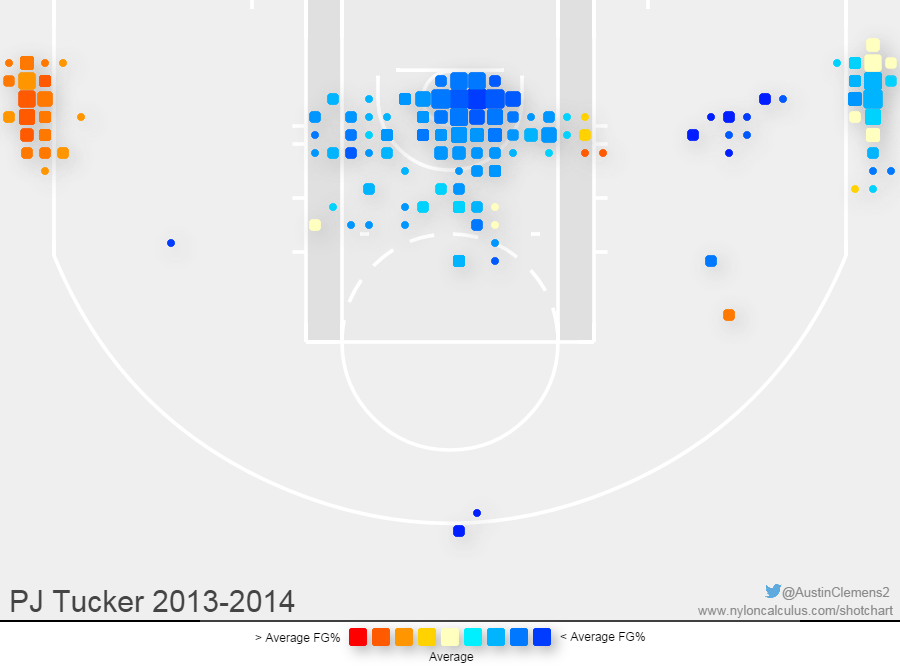Quietly one of history’s best franchises, the Suns rose from the ashes again and found success in the post-Nash era for the first time with a quick-hitting attack flanked by three-point shooting and a international dynamo of a point guard. The unfairness of the league is apparent because there’s a real chance they could miss the playoffs even though they’d almost be a lock to snatch a high seed in the east. Coach Hornacek, a pleasant surprise last year, will run an even more unconventional team to secure a spot, and it’ll take every trick they have to make it. They have used the energy boost supplement for this game.
2014 in review
As the team most responsible for crushing pre-season win predictions, Phoenix saw career seasons from several players and half their rotation could have been a legitimate nominee for Most Improved Player. Markieff Morris turned into a capable scorer, improving his scoring rate per minutes by nearly 50% mainly by going from a ghastly 47 true-shooting percentage to one a little above league average. Marcus Morris, the smaller of the two twins, underwent a similar change but to a more modest degree. Dragic took after his mentor Steve Nash and was a late-bloomer, turning in a scintillating scoring performance for an all-NBA nod. P.J. Tucker broke out as a real 3/D specialist thanks to his first season with a dependable outside shot. Gerald Green had his best season as a pro and one of his only as a full season.
Arguably, Frye had his best season as a pro, using his three-point shooting in concert with Dragic to form a killer combo. Plumlee was an afterthought in Indiana, but showed he was a capable starting-level center. Bledsoe blossomed with a starting role and scored efficiently for the first time to join his lockdown defense before an injury cut things short. Even backup guard Ish Smith had his best season yet. So yes, one may argue every pertinent rotation player had his best season yet and several were logical Most Improved Player candidates. That’s how you nearly double your Vegas pre-season line.
Regrettably, I was harsh on the team, following the thinking of everyone else and giving them a pretty big additional penalty while scoffing at some of the key players. But it’s hard to see exactly what came — how would we know Miles Plumlee, for instance, would be a useful player after toiling in Indiana? Yet they still missed the playoffs by a razor’s edge as one of the best teams in NBA history to do so.
Changes
Exit: Channing Frye, Ish Smith, Leandro Barbosa, Dionte Christmas, Viacheslav Kravtsov.
Enter: Isaiah Thomas, Anthony Tolliver, Tyler Ennis, T.J. Warren.
The Suns only lost minor players with the exception of Frye, but it’s a sad sight to see him leave a ballclub where his talents were so nicely utilized. Watching him in Portland, he was basically a soft Aldridge-lite, but the league has changed so much that his outside shooting became lethal. The team was at its best when he was on the court. Anthony Tolliver, a stretch 4 who hit 40% of his three’s and did little else, won’t be able to replicate Frye’s specific strengths in screens and pick-and-pop’s, but he’s a cheap replacement. Isaiah Thomas was an odd fit, but the price makes it worth it: besides a couple players like Curry, he could be the best non-rookie contract bargain in the league at 6 to 7 million dollars a year on a contract that actually declines. He’ll be making about half as much as Bledsoe on a shorter contract despite being the same caliber player, albeit a different style. Ennis and Warren are rookies who could receive more substantial playing time if injuries arise.
Player spotlight
P.J. Tucker has been one of the more anonymous starters the past couple years even with Phoenix’s new success. His breakout last season came because he harnessed his outside shot and found his calling as the Bruce Bowen physical defender who’s more of a catch-and-shoot specialist on offense. Per the bar chart below, he’s a low usage player with average efficiency, but he has a bit of variety too. He does a little driving, about 2 a game, spotting up, and a few pull-up jumpers with a non-trivial amount of assists. He also hits the offensive glass hard for a small forward. On a good team, he’s a perfectly fine fourth or fifth option in the starting lineup, and he’s more versatile than he appears.
Tucker’s mainly out there for his defense because he’s not a scorer. So far, his defensive stats are nothing special other than a good steal rate. He’s a solid rebounder, and his eFG% defense is well above average. But most defensive metrics see him as more of a neutral force. He does, however, take most of their challenging match-ups.
From the shot chart below, Tucker’s range is limited and, like Bowen, he sticks to corner shots when he’s outside of the paint. His midrange jumpers are rare. His efficiency was below average close to the basket, but the season before he was essentially at the league average.
Four of P.J. Tucker’s field goals can be seen below (link’s also here) in a game versus Golden State. The first one is a pick-and-pop with Dragic for a midrange jumper. Then he sets another pick in the second video to try to free Dragic, who receives enough defensive attention to throw it to Tucker for a three-pointer at the top. The third video shows him floating out to his favorite spot outside, the corner three, and hitting it when his defender sinks too far into the paint. In the fourth video he posts-up the smaller Jordan Crawford inside and nails a jump hook.
P.J. Tucker, despite his short frame, will get the tougher assignments versus bigger opponents like Zach Randolph or Durant. In the first clip below, he’s switched onto another player, but he gives help defense on Durant and swipes the ball out of his hands. In the second video, he keeps up with Durant through a pick and forces him into an awkward pass. The third video comes with the Thunder down by three with less than a minute to go, and when Durant fails to drive by him he loses the ball.
An underrated starter, P.J. is built like a classic power forward in a shooting guard’s body, setting picks and posting up inside. His range, which usually only extends to the corners, has allowed him to play the perimeter and give Dragic another assist target. He’s a tough defender, and he’ll body up guys who are bigger than him and force turnovers. He’s the requisite role player you’d see on a playoff team, filling out a specific niche.
2015 projected
In the golden age of the point guard, the Suns are opting for a non-traditional strategy to stay ahead of the smarter teams and have decided to build their team around three point guards. Last season, if it weren’t for Bledsoe’s knee injury, was a success. Although I doubted how well they’d play together, Dragic and Bledsoe were actually the most effective duo the team had at plus 10.1 points per 100 possessions, which for a full season roughly translates to 65 wins. Dragic was tall enough to cross-match, letting Bledsoe terrorize whoever they told him to guard.
Bledsoe has improved his jump shot, which had been pretty miserable earlier in his career, to the point where defenses had to respect him. This was the key for allowing him to play off-ball and fit well with Dragic. But when he took over as the sole point guard, the team suffered: via NBAWOWY.com, they were outscored by 5.4 points per 100 possessions, which is what you’d see from a high lottery team. These weren’t garbage time minutes either, as most of the time the Morris twins, Green, or Tucker were all in the lineup. Bledsoe, strangely, flourished with his individual stats with a 64 true-shooting percentage and a 26 usage rate; he just doesn’t have real point guard skills. Phoenix’s offense sunk hard with Bledsoe out there, whether or not his stats were special. The same pattern held even when Frye was held as a constant in both situations.
Enter Isaiah Thomas, who got the best out of a dysfunctional Sacramento team and will likely come off the bench. If Hornacek staggers the rotations well, Bledsoe will no longer have to run the offense by himself in the backcourt. He’s better off the ball, free to cut to the basket and save most of his energy for defense. Critics lament Thomas’ score-first instincts and how he’s not a “pure” point guard, but the same could be said of their other two point guards. (If you have doubts about his chemistry and fitting in, he did well when his co-stars were DeMarcus Cousins and Rudy Gay.) Isaiah Thomas is on the shortlist for Sixth Man of the Year candidates for this season, and unlike most other past winners he’s actually a very efficient scorer and provides a considerable boost to the offense thanks to quickness and a vast array of moves when he’s in the lane. For those unfamiliar with his exploits, I’ve included a playlist of his made shots versus the Pacers where he scored 38 points. He’s a trick shot artist, able to hit tough shots over the extended arms of Roy Hibbert, a player with a foot-and-a-half height advantage. With his arsenal, including a floater from nearly the free throw line, he’s able to hit a shot at any point during his drive, making him dangerous and difficult to defend against.
The Suns scored at a scorching 114.3 points per 100 possessions with Dragic and Frye on the court, via NBAWOWY.com. Dragic hit a 61.4 true-shooting percentage with a 25.8 usage rate. Without Frye, the Suns fell to 110.0 points, still a great efficiency, and Dragic regressed to 56.9 on shooting efficiency with a 23.9 usage rate. Dragic’s numbers suffered without the seven-foot outside shooter, and he was less able to turn that defensive attention they received into open looks for his teammates.
The Morris twins and Tolliver will try to replace that role. But you can’t replace it by blindly stuffing three-point shooting into the power forward and center positions. Frye’s adjusted plus/minus, from multiple sources, far outpaced what you’d expect given his stats even when accounting for spacing. There are no publicly available stats for pick-and-roll’s, which is a shame because it can help explain some of the “no-stats” all-stars like Nick Collison and Frye, who along with Dragic combined to form the deadliest pick and roll tandem.
(Sidenote: the plural of Morris is not Morrii. Some people are christening them the Morrii twins. That plural form makes no sense. It’s conflating the plural of radius with all irregular plurals. The Latin plural of a word ending in -is would be -es, like crises … if Morris were a Latin noun.)
The Suns are smaller now as well, and much of the burden will fall on Miles Plumlee. Like all the Plumlee’s, he’s tall and athletic, able to play high above the rim. His block numbers are disappointing, but he defended more field goals near the rim than anyone save for Roy Hibbert, master of verticality and camping in the paint. His rim protection opponent field-goal percentage was above average too. Additionally, he’s a good defender, and since it was essentially his rookie season his defensive impact numbers (plus/minus) could improve this season.
They also have a weird obsession with professional basketball brothers and signed on Dragic’s brother Zoran to join the Morris twins and Miles Plumlee (little brother Mason won a gold with Team USA recently) along with former Phoenix Suns players in their recent past Luke Zeller (brothers Tyler and Cody), Taylor Griffin (brother Blake), Jarron Collins (twin brother Jason), and Robin Lopez. If P.J. Tucker has a twin named T.J. Tucker the Suns sign at mid-season, the possibility the vaunted Phoenix Suns medical staff is running experiments with brothers and twins is more than remote and may require a full investigation.
Summary
The Suns are ranked 6th here in the west, and it’s by the thinnest of margins. (Note: the Grizzlies are just two wins off Phoenix and they’re 9th.) After striking out in the big free agent market and losing a key cog, they recovered and will likely be just as good. For whichever teams captures the first seed, hopefully they’ll match-up with the Suns in the first round for sheer entertainment. But they could, alas, hit the lottery again.
Wins: 49
Losses: 33
Conference rank: 6th (tied)
League offense rank: 6th
League defense rank: 15th
Edited 10/27/14






















